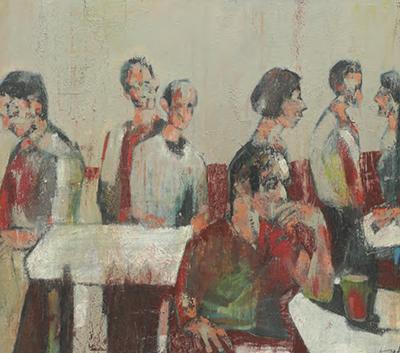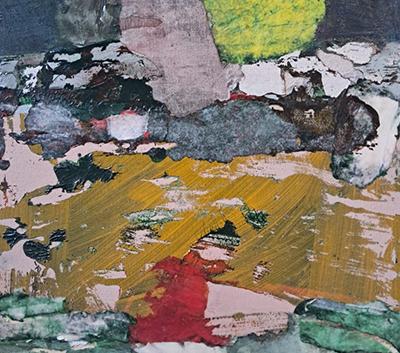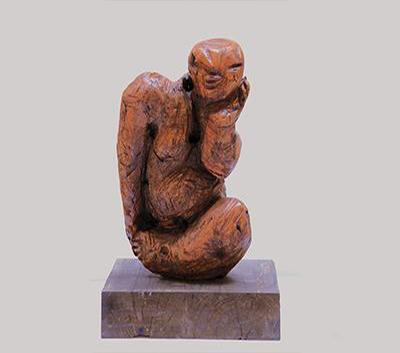Publications
-
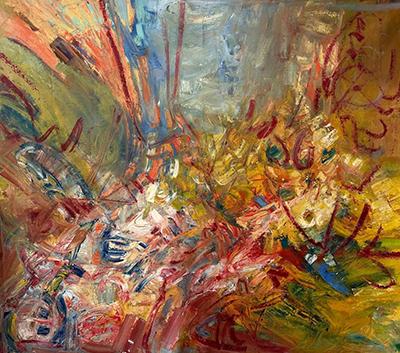
Born in Beirut, Lebanon in 1955, Ghada Jamal started painting in the early 80s and continued her studies at Beirut University College (LAU) later, she immigrated to United States of America to pursue graduate studies. In 1990, she earned Master degree in Fine Arts in Drawing and Painting from California State University Long Beach (CSULB ) and lived in California till her return to Lebanon in 2002.
Over the years, Ghada has exhibited in United States, Europe and the Middle East. She performed fourteen solo shows in Beirut, Lebanon and internationally.
She also participated in several group shows like "Contemporary Art" at City Center Dome, and "The Road To Peace" at Beirut Art Center. Her work is in many permanent collections,including the National Museum of Women in the Arts, in Washington, DC.
For over 17 years, Ghada Jamal taught drawing and painting at American University of Beirut (AUB) and Notre Dame University, Louize. She is currently living and working in the United States of America.
-
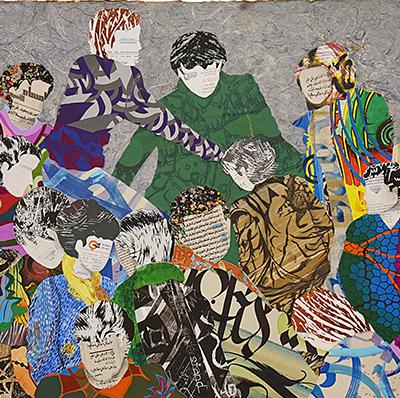
Haibat Balaa Bawab (b.1952) is a Lebanese artist renowned for her pioneering work in collage art. In
her pieces, namely her oil paintings additionally to her collage work, she intricately weaves narratives of
Beirut and its people, along with the scenic mountains and the country’s diverse beauty. The city where
she was born and raised continues to influence her work. Her observations of quotidian Beirut scenes
inspire her to translate these impressions into a distinctive artistic style.
Balaa’s main medium is an assemblage of fragments from popular sources—magazines, stamps, and
bills. She uses said media to map the cultural fabric of the city. By creating figurative images with
abstract elements, she draws on memories of village life, harvests, and bygone eras. Certain motifs
recur in her work; such as carpets, rugs, and oriental tapestries, evoking a sense of serenity and
nostalgia. Her subjects are a reflection of a range of social strata; from haute bourgeoisies’ opulent
houses to the vibrant floral and polychromatic patterns of peasants, refugees, and beggars. All of this
she achieves by using cut-outs as markers of identity and status.
“My artworks in collage and oil painting vary, encompassing cityscapes, local landscapes, heritage, and
nostalgia—reflections of daily life and topical issues. I’m inspired by my surroundings. Even when I
travel, my work mirrors my environment and mood,” Balaa states. Indeed, Balaa’s urban and natural
environments tend to permeate her artistic processes and manifest through her art.
Haibat Balaa received her BA in Fine Arts in 1975 from the Beirut University College [currently the
Lebanese American University]. She holds 17 years of teaching experience at the Lebanese American
University. She also took up the position of Fine Arts Coordinator at the American University of Science
and Technology (AUST) from 2001 until 2022.
Balaa has exhibited in numerous solo shows in Lebanon, Dubai, and Abu Dhabi. The various collective
exhibitions she has participated in include both local and international venues. Locally, these include the
American University of Beirut (AUB), LAU, ALBA, Haigazian, Station Des Arts, and the prestigious
Sursock Museum. Internationally, she has exhibited at Grand Palais de Paris, in addition to shows in
Cairo, Dubai, Abu Dhabi, Bahrain, and Kuwait. In 2019, she was invited to participate in the 8th Beijing
Biennale China.
Haibat Balaa Bawab is a member of the Lebanese Association of Painters and Sculptors as well as the
Artists Syndicate. Her artworks have appeared in publications including a monograph dedicated to her,
titled ‘Haibat Balaa Bawab: The Art of Collage’ (published 2012). Furthermore, she has authored two
AUST publications titled ‘Beyond the Medium I’ and ‘Beyond the Medium II’.
Balaa is an award-winning artist. In 1982, she was awarded the first and only prize by the Central Bank
of Lebanon for designing a new Lebanese currency. She also won first prize at the Makhoul exhibitions
of both 1979 and 1980. She continues to inspire artists and art-enthusiasts in her community.
-
Born in 1974 in Btedaï, in Lebanon’s Bekaa Valley, Imad Fakhry comes from a family of artists. He studied at the Académie Libanaise des Beaux-Arts (ALBA), and received his Master’s Degree from the Ecole Supérieure des Beaux-Arts de Cergy-Paris and the Ecole Nationale Supérieure des Beaux-Arts de Paris. Under the tutelage of French artist Yannick Guéguan, he pursued several courses and workshops in decorative painting and trompe l’oeil.
Imad Fakhry participated in several solo and group exhibitions in Lebanon and abroad, including in Switzerland, the United Kingdom, and the United States. In 2000, he was awarded the ABN AMRO Bank Prize, and in 2007, he was nominated for the Young Creative Awards at the Unesco in Beirut. In 2008, he represented Lebanon with his etchings and engravings at the Triennial of Rhodes, and in 2016, he won the Dr. Chaouki Chamoun prize.
Since 2003, the artist teaches drawing, sketching, etching and trompe-l’oeil at ALBA. .
-
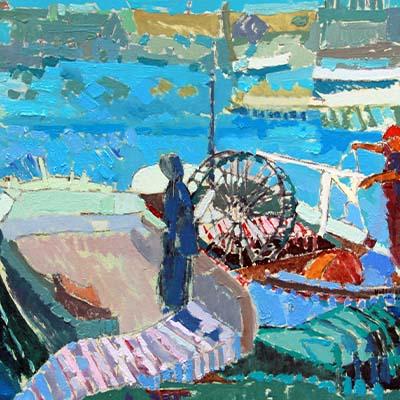
Born in Kuwait in 1968, Issa Halloum graduated from the Institue of Fine Arts at the Lebanese University in 1993, before pursuing studies in Artistic Anatomy at the Brera Academy in Milan in 1999.
Halloum seeks his inspiration in nature. He depicts intricately textured landscapes with vivid colours and airy configurations on canvases and on sculptures, where he plays with the surfaces and textures to create illusions of flatness. He paints from direct observation, carefully studying movement and light, engaging with these elements to create visual experiences rooted in the present moment. His palette is intense and expressive, revealing the significant influence of the great post-impressionist masters. As with Cézanne and Gauguin, he is generous with colors and his brushstrokes are energetic. Both calming and seductive, his paintings with simplified forms have a tangible feel. Whether he is painting a bright landscape, a busy market scene, an intimate view from a balcony, or an anonymous model, the artist freezes the action and the bustle. Additionally, his paintings are expansive. Landscapes and scenes are given room to flourish, creating the impression that the images outstretch the margin of the canvas, celebrating the abundance of nature, while carrying an aesthetic incompleteness that suspends the momentum of the compositions.
Halloum has participated in several individual and collective exhibitions across the Middle East and abroad, notably in Lebanon, Kuwait, Qatar, United Arab Emirates and Italy. His works are part of several regional and global private collections.
-
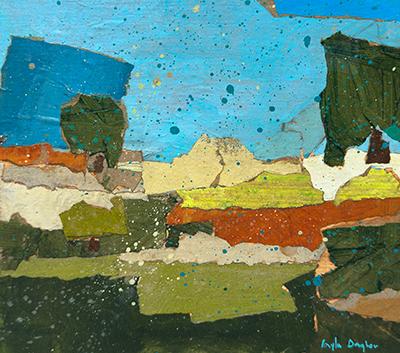
Layla Dagher (b. Beirut) is a contemporary, Lebanese visual artist. She holds a Bachelor of Fine Arts degree as well as a Masters of Visual Arts degree from the Académie Libanaise des Beaux-Arts (ALBA), the latter of which she earned with honours.
In her earlier pieces, she is known for her square compositions resembling window frames, in which figures and animals often appear, with an abstracted landscape or cityscape in the background. Her color palette is always rich and well-studied. In her more recent artworks, she combines the technique of collage and layering with painting, still exploring the city and the landscape as a core subject matter. Her devotion to Beirut and the landscape of Lebanon is evident in the continuous exploration of the subject matter, typically in variations-on-a-theme. Her technique and choice of media is in continuous evolution.
Dagher has participated in numerous solo and group shows in Beirut. She also has exhibited internationally, participating in shows in Tokyo, Seoul and Paris. Her work is featured in esteemed private and public collections including the Lebanese Ministry of Culture. She is a Professor of Fine Arts at the Notre Dame University (NDU), and a member of the Syndicate of Lebanese Artists. She lives and works in Beirut.
-
Born in Lebanon in 1970, Mansour El Habre holds a Diploma in Plastic Arts from the Lebanese University and a
Masters in Plastic Arts from the Balamand University. He teaches Painting and Drawing at the Lebanese Academy
of Fine Arts (ALBA).
Since 1993, El Habre has participated in individual and group exhibitions in his hometown, Geneva,
London, Greece, Canada, Paris, Washington, Kuwait, Dubai, Abu Dhabi and Qatar. He has also been
invited by the Lebanese Ministry of Culture to participate in the International Triennial of Engraving
in Rodeos, Greece in 2008.
His work can be found in private and public collections including in the Audi Bank in Beirut, the
Solidere Headquarters in Beirut and the Cité Social de Fameck, France.
-
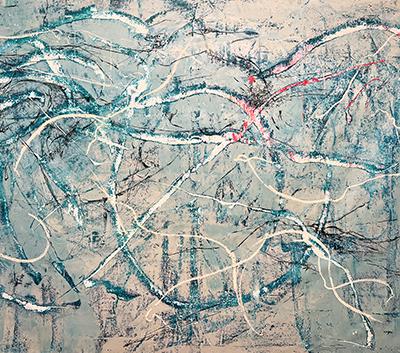
Born in Miami FL Sara is a Lebanese Visual Artist whose practice spans drawing, painting and video art. She has participated in several collective and solo exhibitions in Lebanon, Copenhagen, Berlin, and Canada including her upcoming participation in the collective “Lumiere du Liban” at the Arab Wprld Institute in Paris, were the work will enter the collection of the Institute Reading into the works of Sara Chaar is like jumping head on into a rumbling stream of consciousness, inhabited by insect-like creatures created with instinctual marks, transferring her impulses and feelings directly onto the work.
The process is a cycle of constructing, deconstructing and reconstructing, echoing the never-ending story of Beirut. With construction tools, she accumulates layers of paint and material that work as a foundation that she later on scratches through with screwdrivers, cutters and palette knives, instinctively forcing out transformations leaving behind the memory of her gesture. It is with these textures or realities that Chaar confronts her abstract work. Her work’s aim is to bridge the gap between her poetry and the reality that surrounds her, to discover textures from her environment that tell her a story that belongs to her and that she wants to decipher through her paintings. Out of another crisis, the pandemic, a shattered economy and an uncertain future came a need to put things into a new perspective, in this case a fictional perspective where she uses bold colors as a statement that she likes to call “Imagined Certainty”.
-
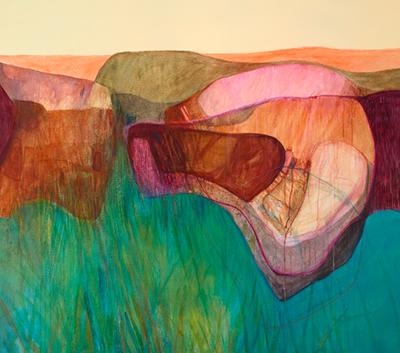
Artist Biography
Born in Beirut, Lebanon, in 1961, Wissam Beydoun received his Bachelor of Arts from the Lebanese American University (LAU) with the Sheikh Zayed Award distinction.
Beydoun’s work explores the connection between nature, light, and form, creating imagined landscapes that evoke emotion and nostalgia. Through a layered approach using watercolor, acrylic, pastel, and mixed media, he portrays the shifting moods of natural environments in compositions that blur the line between abstraction and landscape. He intertwines both elements, merging their distinction into a dynamic and unified composition. His work is a visual meditation on nature’s rhythms, capturing fleeting atmospheres and organic forms through a vibrant interplay of color and depth.
Beydoun has held several individual and collective exhibitions in Lebanon and France, including his participation at the Sursock Museum’s Salon d’Automne. His work is featured in numerous private collections.
Artist Statement
“My childhood summers in the mountains of Bologna, near Dhour el Choueir, were a
gateway to a secret heaven. The woods, with their intricately intertwined branches and
twisted columns, became my sanctuary. The scent of earth and pines anchored me to
those dreamlike moments, where trees and rocks were my companions and the hills my
endless playground.
At dawn, I would rise early to watch Mount Sannine transform with the shifting hues of
sunrise or sunset. The simple act of gathering tree bark, observing pinecones, or shaping
patterns with rocks filled me with wonder. I was captivated by the sunlight piercing
through the trees, casting striking shadows on the forest floor—a natural symphony of light
and form.
Today, these memories flow into my art. I rise before dawn to experiment with watercolors,
layering washes, and pigment to mimic the soft gradients of morning light or the sharp
contrast of shadows. I use watercolor, acrylic, pastel, and mixed media. Through these
techniques, I strive to create visual poetry that evokes the sensations of nature and
transforms them into imagined landscapes.
Each morning is a quiet experiment—a ritual of exploring different methods to capture a
mood, tell a story, or evoke a dream. These early hours allow me to reconnect with the
magic of childhood, creating works where memory and imagination intertwine.”
Wissam Beydoun
-
Yamen Yousef, born in 1982 in Tartous, Syria, is one of the most promising Syrian sculptors. He graduated from the Faculty of Fine Arts, Department of Sculpture in 2005 and is currently pursuing his Masterʼs degree. His work has been the highlight of several solo and group exhibitions in Syria, Lebanon, and most recently part of the Reconciliation through the arts program in Washington DC, New York, Texas and New Mexico, USA.
The sculptures speak volumes while saying nothing at all. Some sculptures give a sense of being suspended in mid-flight whereas others appear to be drawings or sketches that have come to life and taken three-dimensional forms.
His sculptures are usually heavily built formed from carved wood and featuring colored sculpted bodies in different expressive positions and arrangements.
|
|




